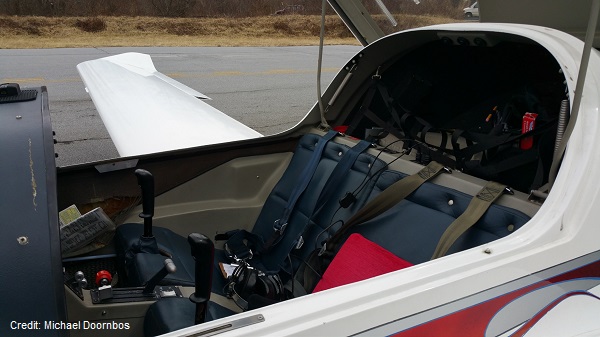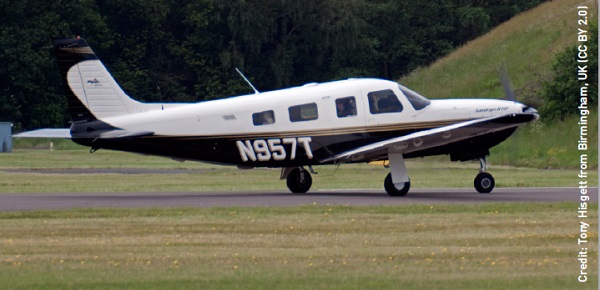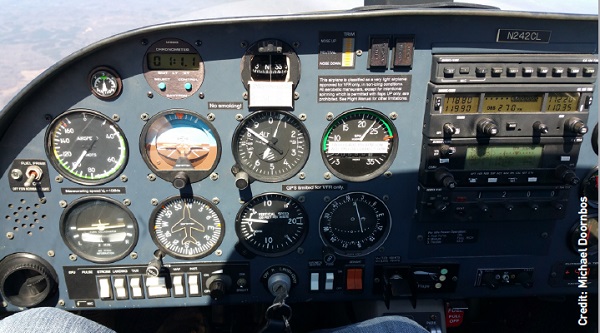It was 9:45pm on a clear, moonless night when I lifted off from the small airport in Western North Carolina, leaving all lights behind. Along with the lights went any reference to the world around me. As I ascended, I searched for a horizontal landmark. Lights on the horizon. A road. River. Anything. The mountainous terrain and the night left me with nothing to see.
“If you lose sight of the horizon, look down at the instruments, they will tell you the truth” my instructor always said in training. Right! But, by the time I Iooked down at my instruments I was already in a 20 degree left hand turn.
In 3 to 4 seconds my body had betrayed me. I had no sense of the airplane turning. It was gradual and unnoticed. My senses had failed me and thankfully my training took over to prevent what could have been a simple but devastating problem. Had I been tired or complacent, my fun night flight of only 6 miles to another airport in town could have ended very differently.
My instruments were just below my line of vision and well illuminated by the panel lights. Thank goodness modern training stresses trust in those instruments. But there is something else and a much more difficult thing to reconcile: I also had to recognise that the airplane was turning. A single engine plane has a natural tendency to turn to the left on its own. Not only that, but it happens too slowly for your inner ear to pick up on the change. Left uncorrected, most single engine aircraft will enter into a steep spiral dive.
Had I been in a different state of mind, had my training been something I just recited instead of studied and believed in, I might have not have noticed in time. If I had a passenger who was talking, or a flock of birds had crossed in front of us, who knows what would have happened.
 Stepping into the cockpit can be made safer with a system that alerts the pilot if they drift too far from level flying.
Stepping into the cockpit can be made safer with a system that alerts the pilot if they drift too far from level flying.
My own experience is a well documented problem yet a solution has proven elusive for years. I suffered from momentary spatial disorientation. My inner ear was deceived by the gyroscopic motions of the airplane and my eyes were not able to tell my brain where the horizon was. In aviation, this is generally considered “not good.”
Imagine coming back night after night with bullet holes in his fighter and then citing that one time he didn’t know which way was up on a flight home as the thing that almost killed him.
This doesn’t have to be the case. Spacial disorientation is a mitigable problem. The attitude indicator in airplanes has been around for almost 100 years and is very capable of telling you what is happening. Of course you have to look at it, understand what it’s telling you, and believe what it is telling you.
Dark history
Spatial disorientation can happen in all types of aircraft, and to any pilot. One of the most famous of these incidents involved the death of John F. Kennedy Jr. in 1999. Kennedy took off from Essex county airport in Fairfield, NJ on a flight to Martha’s Vineyard. It is believed that he lost sight of the horizon. Some pilots in the area reported haze over the open water that evening. Conditions like this would make it almost impossible to judge what was sky and what was ocean. It is believed that the plane slowly entered into a spiral dive and impacted the water, killing Kennedy, his wife Caroline, and his sister, Lauren.
The National Transportation Safety Board (NTSB) launched an investigation and eventually concluded that the crash had been caused by “the pilot’s failure to maintain control of the airplane during a descent over water at night, which was the result of spatial disorientation.”
Spatial disorientation is also a problem for highly experienced pilots. I was sitting with my friend Jerry a few weeks ago as he told me stories of his time as an F-4 Phantom pilot in Vietnam. He flew 221 combat missions in 1968 and 1969. Jerry told me the story of the end of a mission that quickly became hairy while in straight and level flight returning back to base. He and his wingman flew into some clouds and Jerry lost sight of the horizon. Despite being a veteran combat pilot, he didn’t notice his Phantom was slowly banking and entering a shallow dive until his wingman made repeated calls to him over the radio. “Where are you headed, lead?”
They broke through the clouds and he pulled up. At that moment, Jerry realised he had somehow threaded his way into a narrow valley with high mountains to either side of him, reaching far above his current altitude. He considers this the most dangerous flight of the war for him. Imagine coming back night after night with bullet holes in his fighter and then citing that one time he didn’t know which way was up on a flight home as the thing that almost killed him. His instruments were working. He knew better. And yet it was someone else’s voice on the radio that got him home alive. His story certainly got my attention.
In our cars we enjoy safety options like traction control and anti-lock brakes. In General Aviation, complex systems present both a technical challenge and exist in a complicated regulatory environment. The latter is more hurdle than help.
I’m an engineer and inventor by trade so in the days following my “incident” I investigated solutions and put my inventor hat on.
Seeing clearly
I fly a Diamond DA-20-C1. A single engine 2 seat aircraft with excellent visibility and a great glide ratio. It’s a terrific ride. It was built in 1998 and is relatively new for a General Aviation aircraft. Many of the other planes at our small airport have been flying since the 1970s or earlier. It has a standard set of round gauges similar to most aircraft of this size. Flight controls are cables directly connected to my hands and feet via pedals and a control stick. The airplane does have electric trim, but that’s the only flight control that could be manipulated directly.
So, for this very typical aircraft in the GA fleet, what do we need to build to solve the spatial disorientation problem?
If this were a modern fly-by-wire aircraft with a glass panel display a solution might be obvious. We’d do some fancy algorithm work with sensors and take advantage of cheap computing power to design a system much like the traction control in your car. A computer can make decisions much more quickly than your brain. We’d just let it nudge the airplane back to a good flight envelope. This isn’t quite as simple as it sounds to actually implement, but it’s not insurmountable. Twenty-five years from now I suspect this will be standard equipment, just like traction control and anti-lock brakes on your car.
Yet there are thousands upon thousands of perfectly flyable aircraft that fit the description of the Diamond I fly – an older aircraft with directly connected cable flight controls and a mechanical set of instruments whose designs predate WWII. In these cases, creating a solution isn’t so straightforward. Planes like this usually don’t have access to automated manipulation of flight controls and replacing instruments is expensive. In addition many of the instruments you might make changes to are part of the flight certification of the aircraft itself. Few owners will want to make expensive changes to a system that they perceive to be working just fine.
A computer suggesting you “Pull up” or “Bank right” is certainly better than a letter to your family that starts “We regret to inform you…”
The solution I am working to develop is a small general purpose secondary informational system that is semi-portable. Computing power is constantly getting cheaper and faster. How cheap? I built an ADS-B receiver with bluetooth and a 4 inch touch display for $100 with off the shelf parts, over one weekend.
Just like the portable GPS units you see in older General Aviation aircraft, I am building a secondary display “for informational purposes and planning.” But what do we put on it? How do we grab the pilot’s attention when he is in trouble and doesn’t know it?
My prototype concentrates on the display of information to a pilot. First we want him to be aware there is a problem. Then we want to help him do something about it. If we look back at my own spatial disorientation experience and that of my friend Jerry, however, all of the visual input in the world would not have helped if the pilot doesn’t look down at the indicator. The addition of a secondary sensory input is needed.
“Where are you headed, lead?” was a helpful reminder to Jerry. That works great if you’re a combat pilot with a wingman but if you are flying alone then using the intercom of the aircraft or the mp3 input of the pilot’s headset can work by announcing the problem audibly. A voice prompt and a visual queue both indicating I need to “bank right” would get my attention every time.
A computer suggesting you “Pull up” or “Bank right” is certainly better than a letter to your family that starts “We regret to inform you…”
 A Piper Saratoga aircraft similar to N9253N flown by John F. Kennedy Jr. on the night of his fatal crash.
A Piper Saratoga aircraft similar to N9253N flown by John F. Kennedy Jr. on the night of his fatal crash.
 The flight controls of a General Aviation Diamond DA-20-C1.
The flight controls of a General Aviation Diamond DA-20-C1.














